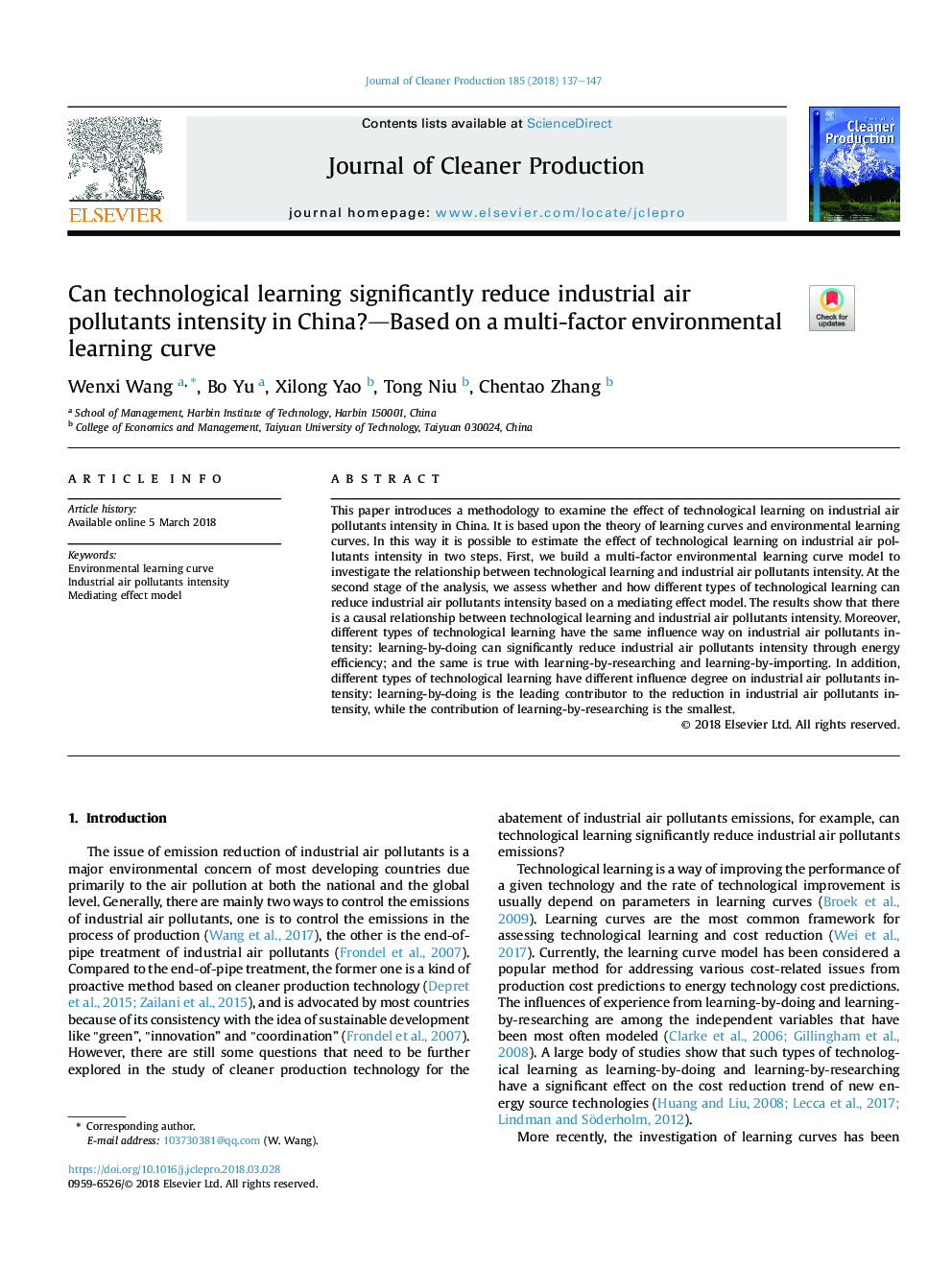| کد مقاله | کد نشریه | سال انتشار | مقاله انگلیسی | نسخه تمام متن |
|---|---|---|---|---|
| 8096384 | 1522068 | 2018 | 11 صفحه PDF | دانلود رایگان |
عنوان انگلیسی مقاله ISI
Can technological learning significantly reduce industrial air pollutants intensity in China?-Based on a multi-factor environmental learning curve
ترجمه فارسی عنوان
آیا آموزش تکنولوژی می تواند شدت آلودگی هوا در چین را به شدت کاهش دهد؟ براساس یک منحنی یادگیری محیطی چند عامل
دانلود مقاله + سفارش ترجمه
دانلود مقاله ISI انگلیسی
رایگان برای ایرانیان
کلمات کلیدی
منحنی آموزش محیط زیست، شدت آلودگی هوا صنعتی، مدل اثر واسطه،
ترجمه چکیده
این مقاله روش شناسی برای بررسی تأثیر آموزش تکنولوژیکی بر شدت آلودگی هوا در صنعت هوا در چین را معرفی می کند. این بر مبنای تئوری منحنی یادگیری و منحنی یادگیری محیطی است. به این ترتیب می توان تأثیر یادگیری تکنولوژیکی بر شدت آلودگی هوا در صنعت را در دو مرحله برآورد نمود. اولا، ما یک مدل منحنی یادگیری محیطی چند عامل برای ایجاد ارتباط بین یادگیری تکنولوژیکی و شدت آلودگی هوا در صنعت ساختیم. در مرحله دوم تجزیه و تحلیل، ما ارزیابی می کنیم که چگونه و چگونه انواع مختلف یادگیری تکنولوژیکی می تواند شدت آلاینده های صنعتی صنعتی را بر اساس مدل اثرگذاری میانجیگری کاهش دهد. نتایج نشان می دهد که بین آموزش تکنولوژیکی و شدت آلودگی هوا در صنعت هواپیما رابطه ای علیه وجود دارد. علاوه بر این، انواع مختلفی از یادگیری تکنولوژیکی تاثیر شدیدی بر شدت آلودگی هوا در صنعت هوا دارد: یادگیری توسط کار می تواند شدت آلودگی های صنعتی صنعتی را از طریق بهره وری انرژی کاهش دهد؛ و همین امر با یادگیری توسط تحقیق و یادگیری توسط واردات صادق است. علاوه بر این، انواع مختلف یادگیری تکنولوژیکی دارای درجه نفوذ مختلف در شدت آلودگی هوا در صنعت هوا هستند: یادگیری توسط کارکنان، عامل اصلی کاهش میزان شدت آلودگی هوا در صنعت است، در حالی که سهم یادگیری توسط تحقیق کوچکترین است.
موضوعات مرتبط
مهندسی و علوم پایه
مهندسی انرژی
انرژی های تجدید پذیر، توسعه پایدار و محیط زیست
چکیده انگلیسی
This paper introduces a methodology to examine the effect of technological learning on industrial air pollutants intensity in China. It is based upon the theory of learning curves and environmental learning curves. In this way it is possible to estimate the effect of technological learning on industrial air pollutants intensity in two steps. First, we build a multi-factor environmental learning curve model to investigate the relationship between technological learning and industrial air pollutants intensity. At the second stage of the analysis, we assess whether and how different types of technological learning can reduce industrial air pollutants intensity based on a mediating effect model. The results show that there is a causal relationship between technological learning and industrial air pollutants intensity. Moreover, different types of technological learning have the same influence way on industrial air pollutants intensity: learning-by-doing can significantly reduce industrial air pollutants intensity through energy efficiency; and the same is true with learning-by-researching and learning-by-importing. In addition, different types of technological learning have different influence degree on industrial air pollutants intensity: learning-by-doing is the leading contributor to the reduction in industrial air pollutants intensity, while the contribution of learning-by-researching is the smallest.
ناشر
Database: Elsevier - ScienceDirect (ساینس دایرکت)
Journal: Journal of Cleaner Production - Volume 185, 1 June 2018, Pages 137-147
Journal: Journal of Cleaner Production - Volume 185, 1 June 2018, Pages 137-147
نویسندگان
Wenxi Wang, Bo Yu, Xilong Yao, Tong Niu, Chentao Zhang,
